#Unite Africa
Text

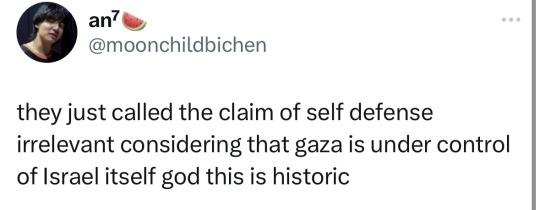
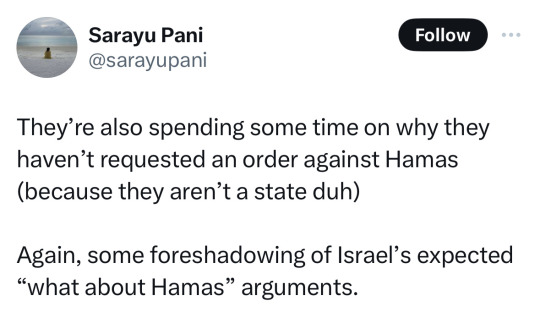

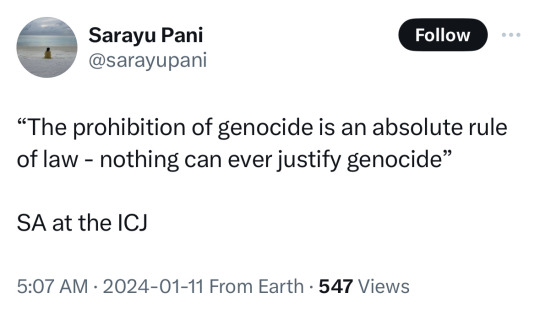

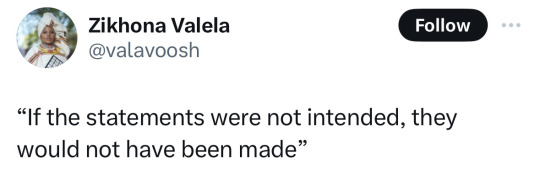

From the court today. Israel IS committing a genocide.
#free palestine#free gaza#Israel#israel is committing genocide#palestine#gaza#south africa#icj#international court of justice#international law#united nations#UN#war crimes#genocide#information#important#current events
27K notes
·
View notes
Text

Huh. says it all really.
#Free palestine#israel#palestine#united kingdom#united states#politics#canada#brazil#france#italy#sweden#norway#south africa#spain#reland#South korea
9K notes
·
View notes
Text

#international#law#international law#israel#free palestine#palestine#gaza#israel massacre#israel is a terrorist state#free gaza#occupied palestine#us#united states#us government#fuck israel#south africa#yemen#news on gaza#mems#facts#important#humans rights
9K notes
·
View notes
Text
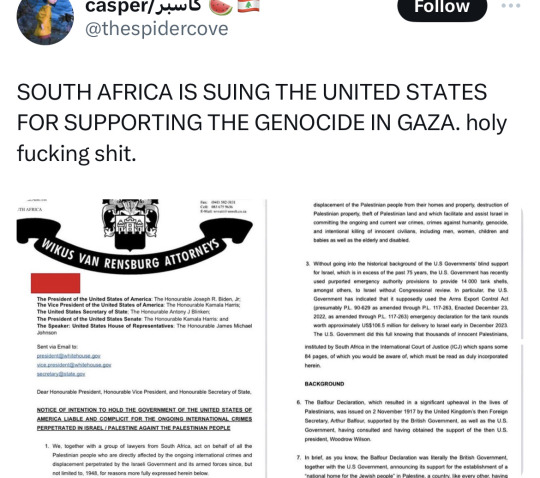
#south africa#free gaza#free palestine#Palestine#from the river to the sea palestine will be free#international court of justice#gaza#fuck israel#fuck joe biden#social justice#anti zionisim#joe biden#yemen#united nations#from the river to the see#history#gaza strip
9K notes
·
View notes
Text
Hello everyone, I wanna highlight this Sudanese family's campaign.
It is only 5k! and they're half way there but haven't gotten any new donations in 4 days! So please Donate & share, let's help this lovely family out 🫶
For more information and Sudanese fund campaigns to support, kindly check this list
Update:
As of Aug. 30th the goal has been extended to $7k. I would like to remind everyone that this campaign feeds 20 ppl and it has been up for 4 months now and the situation has only gotten worse in Sudan, what with the current destructive floodings and heavy rain.
I ask of you to please continue sharing and donating, while I will focus on other Sudanese campaigns 🙏 thank you all.
Sorry for the tags ♡
@magnus-rhymes-with-swagness @appsa @blackfilmmakers @decolonize-the-everything @lesbianmaxevans @parab0mb @goodguydotmp3
#sudan#sudan war#sudan crisis#africa#african politics#humanitarian aid#donate and share#free sudan#RSF#uae#united arab emirates#free palestine#السودان#حرب السودان#الامارات العربية المتحدة
2K notes
·
View notes
Text

i got 12/20
#palestine#gaza#free palestine#free gaza#jerusalem#yemen#lebanon#middle east#human rights#united nations#politics#colonialism#icj#south africa
5K notes
·
View notes
Text

#feminist#feminism#social justice#free palestine#palestine#freepalastine🇵🇸#free gaza#settler violence#settler colonialism#current events#us imperialism#western imperialism#south african politics#south africa#end the genocide#end the occupation#ceasefire now#united states#us politics#african politics#fuck biden#biden administration
4K notes
·
View notes
Text

tags update: hamas is fifth on trending
colonialism is trending too
don't stop talking about palestine
#palestine#free palestine#gaza#israel#free gaza#jerusalem#social justice#colonialism#imperialism#ceasefire now#hamas#israeli apartheid#fuck israel#human rights#south africa#yemen#tel aviv#middle east#us politics#united nations
2K notes
·
View notes
Text
"Namibia is the driest country in Sub-Saharan Africa, and home to two of the world’s most ancient deserts, the Kalahari and the Namib. The capital, Windhoek, is sandwiched between them, 400 miles away from the nearest perennial river and more than 300 miles away from the coast. Water is in short supply.
It’s hard to imagine life thriving in Windhoek, yet 477,000 people call it home, and 99 per cent of them have access to drinking water thanks to technology pioneered 55 years ago on the outskirts of the city. Now, some of the world’s biggest cities are embracing this technology as they adapt to the harshest impacts of climate change. But Namibia leads the way.
How did this come about? In the 1950s, Windhoek’s natural resources struggled to cope with a rapidly growing population, and severe water shortages gripped the city. But disaster forced innovation, and in 1968 the Goreangab Water Reclamation Plant in Windhoek became the first place in the world to produce drinking water directly from sewage, a process known as direct potable reuse (DPR).
That may sound revolting, but it’s completely safe. Dr Lucas van Vuuren, who was among those who pioneered Windhoek’s reclamation system, once said that “water should not be judged by its history, but by its quality”. And DPR ensures quality.
This is done using a continuous multi-barrier treatment devised in Windhoek during eight years of pilot studies in the 1960s. This process – which has been upgraded four times since 1968 – eliminates pollutants and safeguards against pathogens by harnessing bacteria to digest the human waste and remove it from the water. This partly mimics what happens when water is recycled in nature, but Windhoek does it all in under 24 hours...
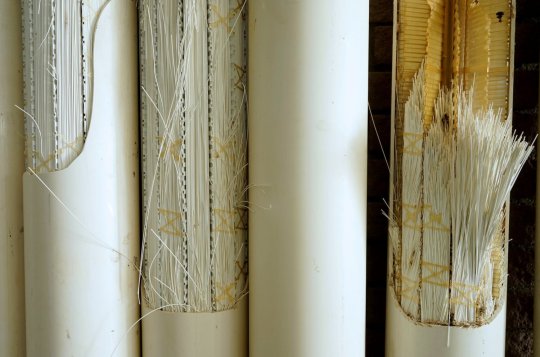
Pictured: These ultrafiltration membranes help to remove bacteria, viruses and pathogens. Image: Margaret Courtney-Clarke
“We know that we have antibiotics in the water, preservatives from cosmetics, anti-corrosion prevention chemicals from the dishwasher,” Honer explains. “We find them and we remove them.”
Honer adds that online instruments monitor the water continuously, and staff ensure that only drinking water that meets World Health Organisation (WHO) guidelines is sent to homes. If any inconsistencies are detected, the plant goes into recycle mode and distribution is halted until correct values are restored.
“The most important rule is, and was, and always will be ‘safety first’,” says Honer. The facility has never been linked to an outbreak of waterborne disease, and now produces up to 5.5m gallons of drinking water every day – up to 35 per cent of the city’s consumption.
Namibians couldn’t survive without it, and as water shortages grip the planet, Windhoek’s insights and experience are more important than ever.
Interest from superpowers across the globe
In recent years, delegations from the US, France, Germany, India, Australia, Singapore, and the United Arab Emirates have visited Windhoek seeking solutions to water shortages in their own countries.
Megadrought conditions have gripped the US since 2001, and the Colorado River – which provides 40 million people with drinking water – has been running at just 50 per cent of its traditional flow. As a result, several states including Texas, California, Arizona and Colorado are beginning to embrace DPR.
Troy Walker is a water reuse practice leader at Hazen and Sawyer, an environmental engineering firm helping Arizona to develop its DPR regulations. He visited Windhoek last year. “It was about being able to see the success of their system, and then looking at some of the technical details and how that might look in a US facility or an Australian facility,” he said. “[Windhoek] has helped drive a lot of discussion in industry. [Innovation] doesn’t all have to come out of California or Texas.”

Pictured: The internal pipes and workings of Namibia's DPR plant. As water becomes scarcer in some parts, countries are looking to DPR for solutions. Image: Margaret Courtney-Clarke
Namibia has also helped overcome the biggest obstacle to DPR – public acceptance. Disgust is a powerful emotion, and sensationalist ‘toilet to tap’ headlines have dismantled support for water reuse projects in the past. Unfortunately, DPR’s biggest strength is also its biggest weakness, as the speed at which water can re-enter the system makes it especially vulnerable to prejudice, causing regulators to hesitate. “Technology has never been the reason why these projects don’t get built – it’s always public or political opposition,” says Patsy Tennyson, vice president of Katz and Associates, an American firm that specialises in public outreach and communications.
That’s why just a handful of facilities worldwide are currently doing DPR, with Windhoek standing alongside smaller schemes in the Philippines, South Africa and a hybrid facility in Big Spring, Texas. But that’s all changing. Drought and increased water scarcity worldwide are forcing us to change the way we think about water.
Now, the US is ready to take the plunge, and in 2025, El Paso Water will begin operating the first ‘direct to distribution’ DPR facility in North America, turning up to 10m gallons of wasterwater per day into purified drinking water – twice as much as Windhoek. San Diego, Los Angeles, California, as well as Phoenix, Arizona are also exploring the technology."
Of course, DPR is not a silver bullet in the fight against climate change. It cannot create water out of thin air, and it will not facilitate endless growth. But it does help cities become more climate resilient by reducing their reliance on natural sources, such as the Colorado River.
As other nations follow in Namibia’s footsteps, Windhoek may no longer take the lead after almost six decades in front.
“But Windhoek was the first,” Honer reminds me. “No one can take that away.”"
-via Positive.News, August 30, 2023
#namibia#africa#desert#water shortage#water conservation#dpr#potable water#water recycling#clean water#drought#united states#colorado river#science and technology#sanitation#good news#hope
2K notes
·
View notes
Text
The United Kingdom has returned 32 gold and silver treasures stolen from the Asante Kingdom more than 150 years ago in what is today’s Ghana on a six-year loan, Ghanaian negotiators have said.
The artefacts, comprising 15 items from the British Museum and 17 from the Victoria and Albert Museum (V&A), were looted from the court of the Asante king during the turbulent 19th-century clashes between the British and the Asante people.
Ghanaian authorities have for years tried to reclaim gold treasures looted by British soldiers from the Asante kingdom, which is also known as Ashanti.
Continue Reading.
482 notes
·
View notes
Text

5K notes
·
View notes
Text
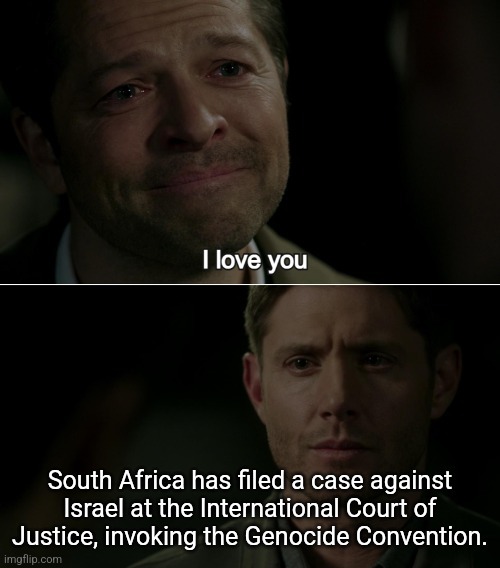
source 1
source 2
source 3
Wikipedia page for Genocide Convention
#destiel meme news#destiel meme#news#world news#us news#israel#israel palestine conflict#israel hamas conflict#free palestine#free gaza#gaza#palestine#i stand with palestine 🇵🇸#south africa#tw genocide#apartheid#genocide#united nations#international court of justice#genocide convention
797 notes
·
View notes
Text
100 Days of War in Gaza.
If you still have the whole 'It's happening miles away, it doesn't affect me' mentality, you are not human.
ahmed_snounu
#palestine#free palestine#free gaza#free west bank#gaza#gaza strip#israel#genocide#social justice#human rights#middle east#jerusalem#tel aviv#south africa#united nations#idf#israeli defence forces#hamas#houthis#hezbollah
780 notes
·
View notes
Text

#yemen#jerusalem#tel aviv#current events#palestine#free palestine#gaza#free gaza#news on gaza#palestine news#news update#war news#war on gaza#apartheid#imperialism#settler colonialism#palestinian state#security council#united nations#south africa
608 notes
·
View notes
Text

100m Finals Paris Olympics 2024
#olympics#paris#paris olympics#100m finals#noah lyles#kishane thompson#fred kerley#akani simbine#marcell jacobs#letsile tebogo#kenny bednarek#olique seville#jamaica#usa#united states#south africa#italy#botswana
359 notes
·
View notes
Text
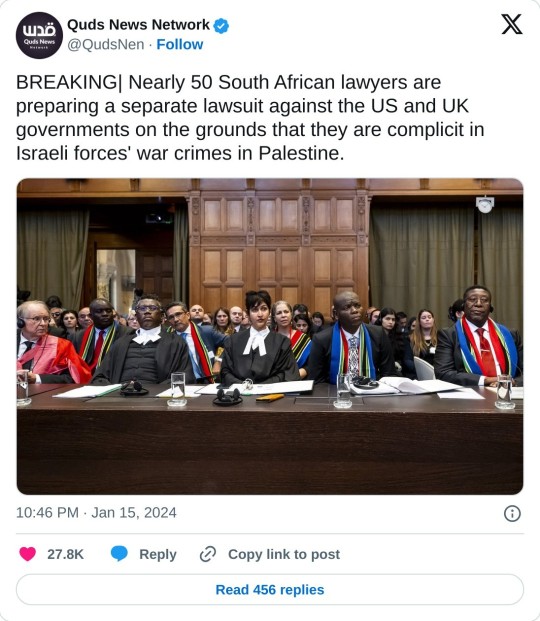
#feminist#feminism#social justice#free palestine#palestine#freepalastine🇵🇸#free gaza#settler violence#settler colonialism#current events#south africa#south african politics#united kingdom#united states#world news#world politics#war crimes#us imperialism#western imperialism#end the occupation#ceasefire now
990 notes
·
View notes